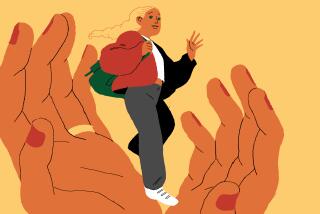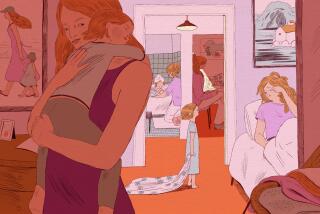Holding Onto the Past While Thinking Only of the Future
- Share via
“Mom?” I started. I waited until we had finished our tuna and caper sandwiches and we were cleaning up. My mother is always more reasonable after she has eaten. “Dan and I have been discussing this for quite some time.” I took a deep breath and she stopped rinsing the dishes. “And we feel, that for the safety of the children. . . .” I had made it this far. I would have to finish. “We insist that you buy a new highchair.”
She resumed rinsing. “All right,” she said.
“We’ll pay for it,” I offered, but she was gone, her mind cast back 25 years, to another house and another life. She had four children under the age of 6, two at the table, one at her breast and the other in the highchair. She boiled red beets and blended them for one child while preparing dinner for the others and my father.
The highchair had been the latest and only model available, a stainless steel tray and frame with a seat cushion the color of 5-day-old pea soup, a late 1960s classic. My parents moved twice after they purchased the highchair. The first time to a bigger house to accommodate more children. The second time years later, they took the chair along as a way of holding onto the past, something concrete that brings back sounds and smells, conversations and feelings.
My mother recalls very little of the outside world from when we all were young. She says she missed a decade. She doesn’t know the music or the politics, but she can still recall what we ate. That was the decade of the highchair.
The highchair was placed in the storeroom, in the front, so that as children whenever we wanted anything out of the storeroom we had to first wrestle with the highchair. We never really questioned its location, but removed it and then replaced it.
But now I see its position was intentional. It was to let us know that in the depths of my mother’s psyche was a woman who planned and saved for the future, someone who can’t throw away a glass jar because there just might be some leftover that would fit perfectly in it. But more telling was my mother’s expectation that we would bring her grandchildren, and she would be ready when they arrived. Crib, portable crib, car bed, toys, books, booster chair, training toilet, children’s spoons, bibs and a highchair.
On the day I arrived at my mother’s house with the first grandchild, my mother took out the portable crib. Dan and I got on our knees, sniffed it, flicked it, and took a knife and chipped it. We weren’t certain the paint was lead-based, but we couldn’t risk it. Not that our newborn could even around move yet, let alone teethe. Then we took out a measuring tape and calculated that the space between the crib bars was too large. A baby could get its head stuck. We refused outright to use the portable crib.
My mother had a difficult time understanding our position. “I’ll have it stripped and repainted,” she suggested. But the problem of the spacing between the bars would still exist. My mother took rags and wrapped them around the bars to narrow the space.
“All four of my children slept in this bed,” she said. “You slept in this bed,” she said to me.
But we decided she was naive. She had raised children without the modern parents’ imagination.
*
When the first grandchild grew into the highchair, Dan and I agreed, both with strong reservations, to try to work with it. We stood in the driveway watching my mother spray down the high chair.
“There are spider webs all over it,” I said. She took a rag and wiped them off. I recognized the rag. It had been a T-shirt of mine from summer camp when I was 9.
“Spiders could be hiding in the hollow legs,” I said. She stuck the hose up each leg and water shot out of the holes.
“I don’t see any spiders, dead or alive, coming out of the holes,” she said.
“That’s because they’re too big to fit,” I said.
My mother dried off the highchair and carried it inside with one hand. The tray required two hands to attach and remove and the clamps threatened to snip off the fingers of children and parents. Dan and I looked each other in the eyes and made a silent promise that we would be careful, always alert to the problem.
Then there were the remains of the highchair’s plastic safety belt that had hardened and cracked apart years ago.
“You can’t put children in a highchair without a belt,” I said. “They can crawl out, slip out, fall out.”
Before I finished my list, my mother left the kitchen and took a walk down the hall. She returned carrying an 8-foot Mexican sash and wound it round and round our daughter, securing her in the highchair.
“It works!” she said.
“What if a child is choking?” Dan whispered to me that night. “We could spend the first 10 minutes untangling the sash.”
I saw his point but pressed him to try it. My mother had not fully recovered from the rejection of the portable crib. The only reason she didn’t insist we use the car bed was that it was illegal.
Instead of the sash, I suggested that Dan, an engineer, figure out a quick-release safety belt. But we never came up with a better design, so at meals at my parents’ home, the pea-green highchair always held our daughter with a brightly colored Mexican sash wrapped around her small body. The weave of the sash became slack with use, so our daughter would begin a meal looking bound to the stake and finish about to disappear under the tray. If it was a long meal like Thanksgiving or Christmas, someone had to retie it.
*
We bought my mother a new highchair. We selected the same model as the one we own. It’s the latest design, and we had a choice of 15. My mother doesn’t like the powder-blue seat with the elephants all over it. But we demonstrated the chair’s features. The tray requires only one hand to slide it on and off, and the safety belt needs only a forefinger and thumb to detach a choking child.
One night, late, I muse to Dan that maybe someday we’ll have grandchildren seated in our powder-blue highchair. But he disagrees with me and says we’ll be forced to buy the latest model that has a voice-activated tray and a built-in Heimlich maneuver device.
“And when our last child has out-grown our highchair,” Dan goes on, “we can place it at the front of our storeroom.”
I am in complete agreement.
Days later, I’m hunched over, half-inside a dark cupboard, rearranging glass jars. I’m trying to make room for an addition. I’ve just peeled a label off an empty mustard jar because I like the feel of the jar in the curve of my hand. I tell myself it’s different than my other mustard jars because its lid is black plastic so it will resist corroding at the edges.
When I feel my back press against the top of the cupboard, I think of my mother. My posture is hers. I’ve seen her inside cupboards before. My hands are hers too--careful and yet quick with glass. And my thoughts are hers.
I’m thinking about the highchairs. Why place our powder-blue chair in the storeroom when we’ve finished with it and leave it to chance that my children will have significant encounters with it? I’ll keep it by the back door. I’ll put the pea-green one there too.
Each decade the highchairs will have a new purpose--a place to pile preschool paintings, then lunch boxes, backpacks and finally car keys. And in the depths of my children’s psyches, they will know that a highchair’s greatest and truest purpose is for containing and feeding small children, my grandchildren.
I fit a tall, skinny olive jar inside a pickle jar. I’ve made a place for the mustard jar. During this moment of elation, I realize I have become my mother.






